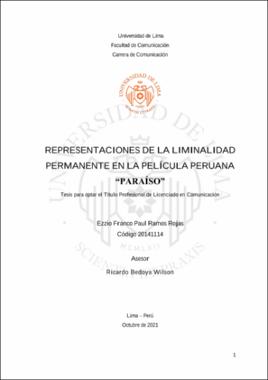Mostrar el registro sencillo del ítem
Representaciones de la liminalidad permanente en la película peruana “Paraíso”
| dc.contributor.advisor | Bedoya Wilson, Ricardo Humberto | |
| dc.contributor.author | Ramos Rojas, Ezzio Franco Paul | |
| dc.date.accessioned | 2022-02-03T19:45:21Z | |
| dc.date.available | 2022-02-03T19:45:21Z | |
| dc.date.issued | 2021 | |
| dc.identifier.citation | Ramos Rojas, E. F. P. (2021). Representaciones de la liminalidad permanente en la película peruana “Paraíso” [Tesis para optar el Título Profesional de Licenciado en Comunicación, Universidad de Lima]. Repositorio Institucional de la Universidad de Lima. https://hdl.handle.net/20.500.12724/15097 | es_PE |
| dc.identifier.uri | https://hdl.handle.net/20.500.12724/15097 | |
| dc.description.abstract | The film Paraíso (2010), by Héctor Gálvez, brings together various socio-historical processes experienced in Peru during the last quarter of a century. Through a semiotic analysis of the journey of the five protagonists, it is obtained that their narratives are unfinished or uncertain. To understand this incompleteness, the author updates the concept of liminality towards its permanent character. With this, a relationship is established with the context presented by the film: the post-conflict and the post-memory. It is also represented in other elements of the film, such as the perpetual transit of the characters, the absence of "final" stages in their stories, or the intrusion of "the real" into the frame. Permanent liminality allows a narrative and figurative analysis, no longer from or towards fixed and determined states, but within the margins, uncertainty and transition. | en_EN |
| dc.description.abstract | La película Paraíso (2010), de Héctor Gálvez, congrega diversos procesos sociohistóricos vividos en el Perú durante el último cuarto de siglo. Mediante un análisis semiótico del recorrido de los cinco protagonistas, se obtiene que sus narrativas quedan inconclusas o inciertas. Para entender esta incompletud, el autor actualiza el concepto de liminalidad hacia un carácter permanente del mismo. Con ello, se establece una relación con el contexto que presenta el filme: el posconflicto y la posmemoria. También es representada en otros elementos de la película, como el tránsito perpetuo de los personajes, la ausencia de estadíos “finales” en sus historias, o la intromisión de “lo real” en el encuadre. La liminalidad permanente permite un análisis narrativo y figurativo, ya no desde ni hacia estados fijos y determinados, sino al interior de los márgenes, la incertidumbre y la transición. | es_PE |
| dc.format | application/pdf | |
| dc.language.iso | spa | |
| dc.publisher | Universidad de Lima | |
| dc.rights | info:eu-repo/semantics/openAccess | * |
| dc.rights.uri | https://creativecommons.org/licenses/by-nc-sa/4.0/ | * |
| dc.source | Repositorio Institucional - Ulima | es_PE |
| dc.source | Universidad de Lima | es_PE |
| dc.subject | Discourse analysis | |
| dc.subject | Semiotics and cinema | en_EN |
| dc.subject | Peruvian cinema | en_EN |
| dc.subject | Liminality | en_EN |
| dc.subject | Análisis del discurso | es_PE |
| dc.subject | Semiótica y cine | es_PE |
| dc.subject | Cine peruano | es_PE |
| dc.subject | Liminalidad | es_PE |
| dc.title | Representaciones de la liminalidad permanente en la película peruana “Paraíso” | es_PE |
| dc.title.alternative | Representations of permanent liminality in the peruvian film “paraíso” | en_EN |
| dc.type | info:eu-repo/semantics/bachelorThesis | |
| thesis.degree.level | Título Profesional | es_PE |
| thesis.degree.discipline | Comunicación | es_PE |
| thesis.degree.grantor | Universidad de Lima. Facultad de Comunicación. | es_PE |
| dc.publisher.country | PE | |
| dc.type.other | Tesis | |
| thesis.degree.name | Licenciado en Comunicación | es_PE |
| renati.advisor.orcid | https://orcid.org/0000-0003-2780-6648 | |
| renati.discipline | 322026 | |
| renati.author.dni | 72606389 | |
| renati.level | https://purl.org/pe-repo/renati/level#tituloProfesional | * |
| renati.advisor.dni | 07786983 | |
| renati.juror | Bailón Maxi, Jaime | |
| renati.juror | Cabrejo Cobian, Jose Carlos | |
| renati.juror | Bedoya Wilson, Ricardo Humberto | |
| renati.type | https://purl.org/pe-repo/renati/type#tesis | * |
| dc.subject.ocde | https://purl.org/pe-repo/ocde/ford#5.08.00 | |
| ulima.cat | OI |
Ficheros en el ítem
Este ítem aparece en la(s) siguiente(s) colección(ones)
-
Tesis [190]



